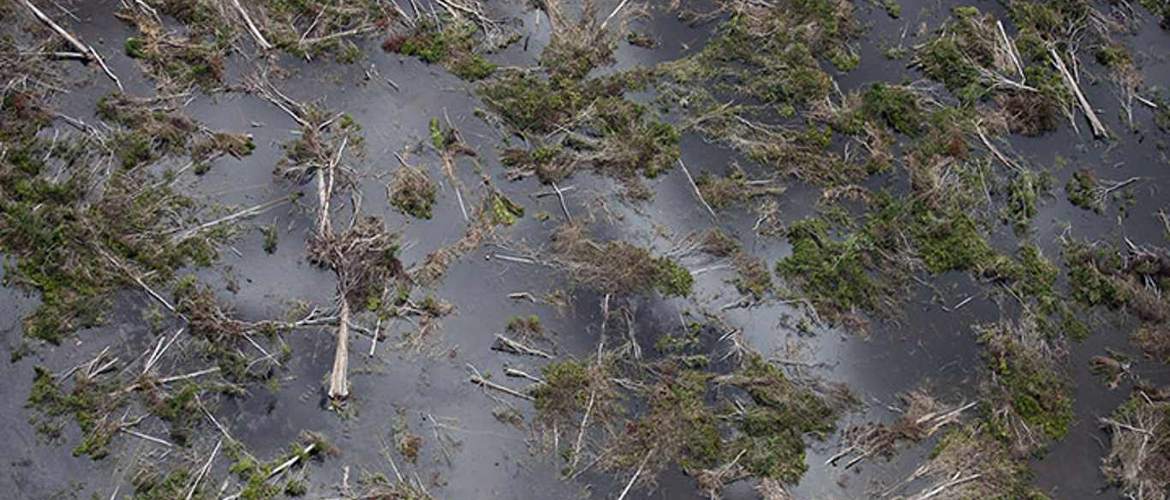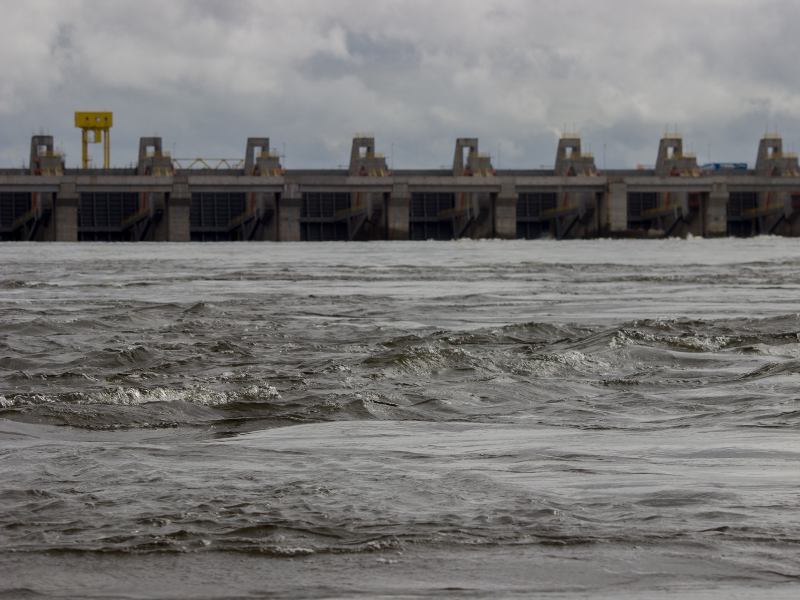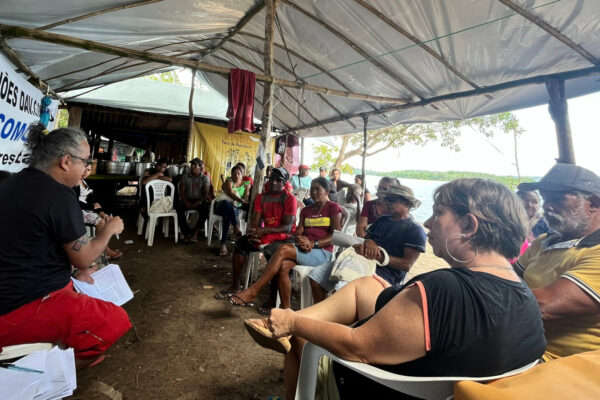In August we shared some good news: Brazil’s environmental agency IBAMA definitively shelved plans to carve the São Luiz do Tapajós mega-dam into the heart of the Amazon after deeming the project a socio-environmental liability for its devastating impacts upon the lands and way of life of the Munduruku people.
However, despite that good news, the archiving of this project does not mean another, similar project won’t be proposed. In fact, rumors have begun to circulate to that effect. Furthermore, the more than 200 dams and other mega projects planned along the Amazon River’s tributaries make clear that the fight against destructive mega-dams is not over.
Aren’t hydroelectric dams clean energy?
Brazil is sometimes touted as one of the countries with the highest percentage of “clean” energy, with about 90% of its energy coming from renewable hydropower sources. However, considering the destruction needed to build and maintain large-scale hydroelectric dams, they can hardly be considered clean.
To start, hundreds of acres of forest are cut down and flooded to build hydroelectric dams. In this process, the forest passes from being a carbon sink to being a source of carbon dioxide and methane released into the atmosphere. The damming of a river then distorts its natural course, severely disrupting the natural seasonal cycles of riverine plants and animals and leading to a ripple effect in which the loss of nesting sites and flooded habitats cause migrations, reduction, or even extinction of species.
Further, the energy produced by dams and the roads opened to reach make the area more accessible to other development, literally paving the way for the logging and mining industries, in addition to illegal versions of these activities.
Indigenous populations also directly experience the changes caused by hydroelectric dam construction. The sacred lands on which their cultures rely are destroyed by dam construction and its effects, as are the livelihoods of all the communities that survive by fishing. Riverine indigenous communities are also believed to be the first to be affected by health issues related to dams: the fish that do survive the rerouting of the river often carry dangerous amounts of mercury due to this toxic substance being locked into dams’ stagnant reservoirs.

Dams are highly inefficient energy sources
Typically in Brazil, the bigger the hydroelectric dam, the further away will it be from the place where the energy will actually be consumed, requiring long transmission lines that can cross through multiple states. This not only adds to the cost, but means that a significant part of the energy is lost during transmission.
Paradoxically, dam construction makes hydroelectric power generation less productive. Due to the deforestation caused by dams, the moisture-trapping power of all those trees disappears, leading to a drop in precipitation levels, in turn reducing the river’s water level, making the dams less efficient than planned. In some cases, the miscalculations of hydroelectric power production has led to the formation of seasonal swamps near the dams, rendering them utterly useless during long periods.
The social costs of dams
The effects of large dams on indigenous peoples are rarely considered, as reflected in the routine violation of their right to consultation during environmental impact assessments. This lack of consultation, though required by international norms, likely stems from an understanding that indigenous peoples are the main obstacles to the building of the dams, given their opposition to dams’ effects on their territories and livelihoods.
Helpful in getting around this obstacles is the popular myth in Brazil, which has existed since at least the construction of the first hydroelectric dams projects decades ago, of the “uninhibited Amazon,” available for those who want to colonize and exploit it. In reality, of course, the Amazon is far from uninhabited. For millennia it has been home to many indigenous peoples. In the Tapajós River basin, one of the tributaries of the Amazon River, there are more than 200 indigenous communities. Additionally, the Brazilian Constitution enshrines the right of indigenous communities not to be displaced from their territory. But this “inconvenience” has easily been overlooked, perpetuated by the prevalent myth of an uninhabited Amazon.

Local resistance to mega-dams
These indigenous communities refuse to be forgotten, however, and in the face of the threats posed by dams they have developed innovative strategies to defend their territories and ways of life. The Munduruku, for example, are pursuing a legal strategy, pushing for demarcation of their territory and building a formidable legal roadblock to their dam-driven relocation. They have taken this fight all the way to capital cities, where they have demonstrated, occupied governmental buildings, and attended high-level meetings.
At the end of November, the Munduruku traveled to the country’s capital, Brasilia, to stage a “mannequin challenge” demonstration calling for the demarcation of their land. As Chief Saw Munduruku said to EFE News: “White men know those lands are ours but don’t respect their limits, which makes demarcation necessary in order to give the Indian people more protection.”
Indigenous peoples aren’t the only ones who would be affected by the construction of dams on the Tapajós River. Civil society movements such as the Movimento Tapajos Vivo (MTV), based in Santarem at the mouth of the Tapajós River have also been organizing to oppose new dams.
The MTV formed before dams were even being discussed for the Tapajos, when one of the city’s main beaches, also one of the region’s most important archeological sites, was transformed into an enormous soy shipping port owned by the American multinational Cargill. That event brought together a diverse array local activists – religious groups, members of indigenous organizations such as the CITA (Conselho Indigena Tapajos Arapiuns), professors, NGOs, students, researchers, etc. – to create the MTV in an effort to protect the Tapajós River basin.
In helping lead the fight against dams and other mega projects, the MTV has organized massive public events such as the Caravan in Defense of the Tapajos River. The Caravan demonstrated to national and international audiences how local communities – indigenous and traditional peoples as well as urban dwellers – are unified against the construction of dams on the Tapajós, which they believe represent the destruction of “their territory, their river, their life”. The second Caravan, which took place in August of this year, aimed not only to reject dams on the Tapajós, but also to propose alternatives to those “projects of destruction” that would respect the cultures, peoples and ecosystems that depend on the Tapajós. And more than a demonstration against something, the Caravan was the union of struggles, peoples and ideas in order to defend a way of life.

With all these risks, why does Brazil continue to pursue dam construction?
If dams pose so many risks and inefficiencies, it becomes difficult not to conclude that the motivation for their construction are the political and financial benefits they provide to a powerful few. Indeed, if the government truly wanted to promote clean energy, it could focus on increasing the efficiency of the energy grid and reducing wasteful energy consumption. As Philip Fearnside, professor at Brazil’s National Institute of Research in the Amazon (INPA), said recently, “The first priority [for Brazil should be] to use less electricity,” and if the country needs to move beyond energy efficiency to increase production, then “Brazil has enormous potential for wind and solar power.”
Instead, as a recent investigation by Mongabay uncovered, “the building of mega-dams (including the recently completed but controversial Belo Monte Dam) has hugely benefited Brazil’s gigantic construction firms, along with the nation’s political parties, who in the past have received very generous campaign contributions from contract-winning companies.”
This coziness between the political and economical sector in Brazil isn’t new, and has led to policies such as as those ushered in during the administration of former president Dilma Rousseff like the Forest Code (Codigo Florestal), which reduced environmental protection of the Amazon forest and riverbank areas and handed more power to agribusiness. Such coziness has continued with the Temer administration. Indeed, the agribusiness sector and Brazil’s executive are becoming more closely aligned, and energy needs are being dealt with as they are because national and international corporations have interests in that sector.
One of the strongest sectors pushing for such changes is the soy industry, which would greatly benefit from the construction of dams and the new waterways created by them. Not only has increased soy production in Brazil led to massive deforestation for new plantations, but the soy’s main purpose – to feed livestock – is itself among the greatest causes of the destruction of the Amazon. With the vast majority of Brazilian soy destined for export, dozens of new dams in the Tapajós basin lay the groundwork for industrial waterways to facilitate bringing this commodity to market.
As the new Temer administration plots a course to solve the country’s current economic crisis by increasing agro-industrial production, it has begun to adopt additional policies to support these industries rather than address the environmental crisis in the Amazon. For example, while under previous administrations some lines of communication existed between the indigenous populations and the government, new reforms essentially eliminate them. For example, the Ministries of Agriculture and Energy now play a key role in the indigenous land demarcation processes. Previously, this role fell to the federal indigenous agency FUNAI, which ultimately decided whether the requests for demarcation from indigenous communities – usually supported by findings from anthropologists and scientists – should reach the president’s desk for approval.
Given that one of the main obstacles to big agribusiness and so-called development projects are indigenous peoples and their protected territories, it is hard to imagine that the Agriculture and Energy Ministries will now willingly condemn such projects to defend indigenous rights, particularly when the new Minister of Agriculture, Blairo Maggi, owns lands that would be directly served by new waterways planned for the Tapajós River.
Even worse, these conflicts aren’t just legal. They are also manifested in the rise of violence between big landowners and indigenous populations, which has led to the death of numerous indigenous leaders and activists fighting for their rights. In 2015 alone, 137 indigenous activists were killed, according to Brazil’s Indigenous Missionary Council (Cimi).
As such, we can say that the hydroelectric dams are a reflection of the system’s problems: corruption, injustice and inequality.
Reflections on the Tapajós River from the author
I spent the last six months living in Santarém, a small city on the Tapajós River, working with social movements and indigenous peoples, and learning about the struggle to preserve this irreplaceable environment. Throughout my stay in the region, I realized how essential the river really is to all of its peoples. Everything is related to it: their culture, their food, and even the songs they listen to are inspired by the river. But also more “practical” aspects of their lives: transportation depends on the river, so visiting family often means a two-day boat trip, for example. Cities and towns are built facing the river. Everything is turned towards it. How can its destruction be justified?
It is hard to imagine that the biggest forest in the world and it’s awesome rivers could come to an end, but it’s already been deforested by more than 20%. The negative feedback loop described in this post could trigger a spiraling destruction of the Amazon, with all of the consequences that would bring.
We live in a world where it is easy to live comfortably and ignore the suffering of others, but we must understand that our comfort won’t last. It’s no longer a question of “what world will we leave for our children?”, but rather, “in what world are we living?” Destruction is not something that will happen, it is something that is happening. The way we think, the way we consume, and the way we get involved in positive change must evolve and adapt to today’s complex challenges.














